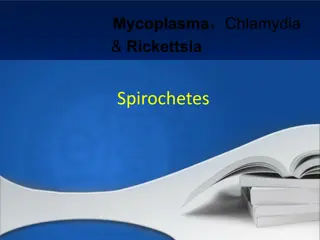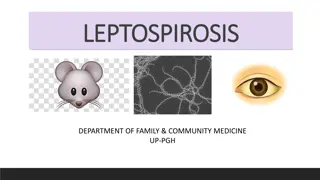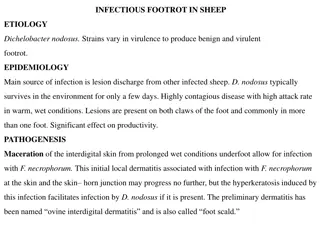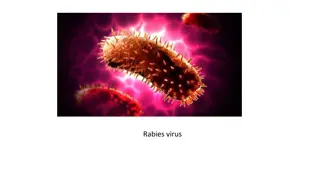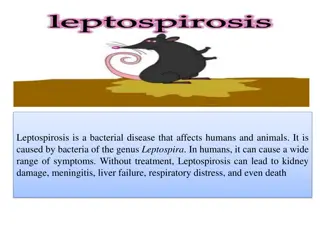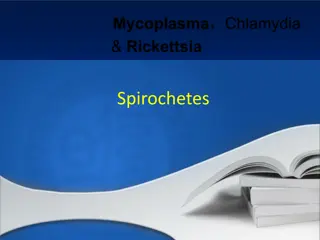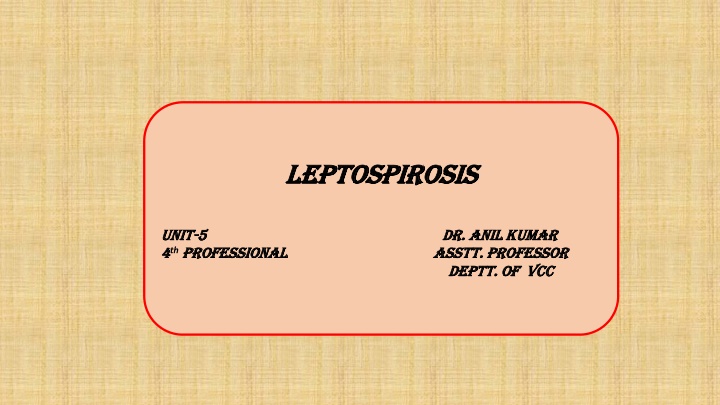
Leptospirosis: Causes, Transmission, and Pathogenesis
Leptospirosis, also known as Jaundice/Rice disease or Sugarcane worker's disease, is caused by pathogenic Leptospira bacteria. It is an occupational disease affecting humans and animals, transmitted through direct contact with infected urine. Learn about the various serovars, hosts, and pathogenesis of this infectious disease.
Download Presentation

Please find below an Image/Link to download the presentation.
The content on the website is provided AS IS for your information and personal use only. It may not be sold, licensed, or shared on other websites without obtaining consent from the author. If you encounter any issues during the download, it is possible that the publisher has removed the file from their server.
You are allowed to download the files provided on this website for personal or commercial use, subject to the condition that they are used lawfully. All files are the property of their respective owners.
The content on the website is provided AS IS for your information and personal use only. It may not be sold, licensed, or shared on other websites without obtaining consent from the author.
E N D
Presentation Transcript
Leptospirosis Leptospirosis Unit Unit- -5 5 4 4thProfessional Professional Asstt Deptt Dr. Dr. Anil Kumar Anil Kumar Asstt. Professor . Professor Deptt. of VCC . of VCC
LEPTOSPIROSIS Jaundice/Rice Synonyms: disease/Sugarcane worker's disease Traditionally(Serological reaction), Leptospira were divided into two groups i.e the pathogenic Leptospira saprophytic Leptospira ( L biflexa). On the basis of antigenic composition and serological reactions, more than 250 serovars in 23 sero-groups defined. They are usually visualized using dark-field microscopy. Silver impregnation and immunological staining techniques. Leptospirosis is an occupational disease. Host Affected: All domestic animals and human. Transmission: The disease is common in areas where climate is warm, humid and alkaline soil with abundance of surface water. Pathogenic leptospires can persist in the renal tubules or in the genital tract of carrier animals. Although indirect transmission can occur when environmental conditions are favourable, these fragile organisms are transmitted most effectively by direct contact. Urine is the chief source of contamination. Pig and Cattle are may pass the organism after recovery for a longer duration. Weill's disease/Infectious field worker's (L interrogans) and the Dark Field Microscopy
Maintenance hosts are the main source of environmental contamination and of natural transmission to other animal species which are termed incidental hosts. Incidental host species usually exhibit low susceptibility to infection, develop severe disease and are inefficient transmitters of leptospires to other animals. The source of infection is an infected animal which contaminates pasture, drinking water and feed by infected urine, aborted foetuses, and infected uterine discharges. Maintenance and incidental hosts for important serovars of Leptospira interrogans: SEROVAR MAINTANENCE HOST INCIDENTAL HOST bratislava Pigs, hedgehogs Horses, dogs canicola Dogs Pigs, cattle grippotyphosa Rodents Cattle, pigs, horses, dogs hardjo Cattle. (sheep occasionally) Humans icterohaemorrhagiae Brown Rat Domestic animals, humans pomona Pigs, cattle Sheep, horses, dogs
Pathogenesis: Enzymes capable of degrading host cell membranes Organism enters to the body through mucous membranes and damaged skin haematogenous spread with localization and proliferation in organs(Liver/Spleen/Kidneys/Eyes/Meninges/fetuse s) Affecting epithelial tissues through andchemotaxis(Hyalunorni dase) parenchymatous motility Affecting vascular endothelium leading to haemorrhages Infection is cleared within 10 days after bacteraemia due to phagocytosis by macrophages in presence of Ab production but, some may escape and tend to persist in sites such as renal tubules, eyes and uterus where Ab action in minimal Due to production of haemolysin, it causes haemoglobinuria in young calves Important: 1. Equine recurrent uveitis(Moon blindness or periodic opthamia) is thought to involve the production of antibodies against leptospiral antigens, probably membrane proteins, which cross-react with ocular tissues and abortion is the common manifestations . 2. In canine leptospirosis manifestations are septicaemic, hepatic and renal disease. 3. In cattle and Swine septic illness is confined to young and abortion is main manifestation in Adult.
Pathogenesis: FEVER/PYREXIA
Clinical Signs: CATTLE PIGS DOGS HORSES SHEEP Subclinical with or without leptospiruria Milk-drop syndrome, with or without any other clinical signs (often Hardjo) Abortion neonatal mortality: abortion (Pomona) sporadic (Hardjo) Haemoglobinuria, jaundice and fever in calves, and commonly, in young adults. Serovars commonly involved Pomona, Grippotyphosa and Icterohaemorrhagiae Subclinical, with (especially Pomona) Fever and focal non- suppurative mastitis and leptospiruria Infertility, abortions and (Canicola, Pomona,Icterohaem orrhagiae Bratislava) Fever, jaundice, haemoglobinuria and high mortality in young pigs (often Icterohaemmorhagia e often Subclinical leptospiruria (often Canicola) Acute haemorrhagic disease: high fever, vomiting, prostration and often death Icterohaemorrhagiae ) Acute renal failure (many including Icterohaemorrhagiae , Grippotyphosa and Bratislava) Infertility, abortions and (Bratislava) with Recurrent iridocyclitis ( periodic ophthalmia moon which can result in blindness Occasionally abortion with foetuses of six months to term Rarely fever, anorexia, depression and icterus Mainly infections leptospiruria (serovars such as Hardjo) Occasionally, acute leptopirosis depression, dyspnoea, haemoglobinuria, anaemia and high mortality in lambs (often Pomona subclinical leptospiruria with or blindness ) early with and stillbirths (usually storms and abortions or serovars Canicola, anorexia, less stillbirths are
Diagnosis: Clinical signs, together with a history suggestive of exposure to contaminated urine, may suggest acute leptospirosis. Organisms may be detected in fresh urine by dark-field microscopy, which is relatively insensitive. Serological tests: Microscopic agglutination test (MAT) ELISA: Tests for the detection of both IgM and IgG are available and include rapid tests which can be performed in the field . Complement fixation test Fluorescent antibody procedures are often used for the demonstration of leptospires in tissues. Animal inoculation:Weanling gerbils, hamsters and guinea pigs can be inoculated intraperitoneally with 0.5 1.0 mL of neutralized urine, unclotted blood or a 10% tissue suspension in EMJH or 1% BSA. Molecular diagnosis and typing(PCR)
Treatment and control: To be save the liver and Kidney before irreparable damage. Doxycycline and tetracycline, agents. Streptomycin@12mg/Kg IM /Penicillin@44000 IU/ Kg IM. Antibiotics + Corticosteroids used to remove urea and shedding of organism. In haemolytic anaemia, blood transfusion. Prevention/Control: Isolation of diseased animals for at least 2 weeks and premises, tool etc. should thoroughly disinfected. The animal who continued shedding of organism should preferably be slaughtered and buried/burnt. To control carrier (Rodents) chemical (Zinc phosphide) is effective. The animal sheds should be covered with wire nets to check entry of carrier animals. Use microscopically fresh water/Ponds and KMnO4 may be used. Use vaccination; L. canicola and L. icterohaemorrhagica is used against canine leptospirosis.



